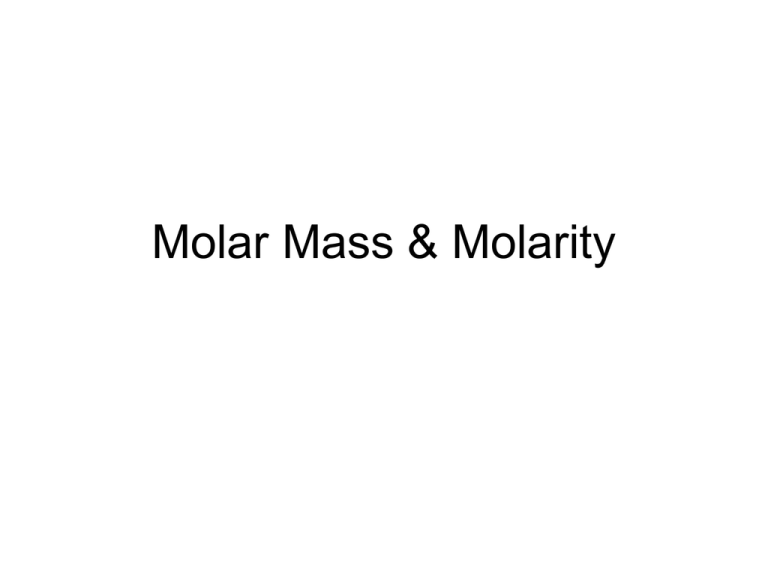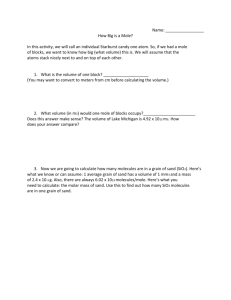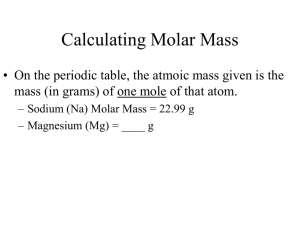Molar Mass & Molarity
advertisement

Molar Mass & Molarity Molar Mass • Mass in grams of one mole of an element or compound. • Numerically equal to the atomic weight of the element or the sum of all the atomic weights in the formula. • Round all atomic masses to keep 2 decimals. Molar Mass Examples • NaCl = 22.99 + 35.45 = 58.44g/mole • CuSO4 . 5H2O (this is a hydrate; it means there are 5 water molecules added for each copper sulfate molecule) = 63.55 + 32.07 + 4(16.00) + 5(18.02) = 159.62 + 90.10 = 249.72 g/mole Practice 1) KCl 2) Li2SO4 . 3) (NH4)2C2O4 H2O Answers 1) KCl= 39.10 + 35.45 = 74.55g/mole 2) Li2SO4= 2(6.94) + 32.07 + 4(16.00) = 109.95g/mole 3) (NH4)2C2O4 . H2O = 2(14.01)+8(1.01)+2(12.01)+4(16.00)+18.02 =142.14g/mole Practice Again 4)potassium hydroxide 5) copper (II) bromide 6) magnesium phosphate Answers 4) KOH = 39.10 + 16.00 + 1.01 = 56.11g/mole 5) CuBr2 = 63.55 + 2(79.90) = 383.15g/mole 6) Mg3(PO4)2= 3(24.31)+ 2(30.97) + 8(16.00) = 262.87g/mole Molarity, M • Moles of solute (compound) per liter of solution. • Moles divided by volume (in liters). – You will have to convert mL to L. 1.5M HCl • This means there are 1.5 moles of HCl in each liter of HCl • How many grams of HCl are in 0.45 liters of 1.5M HCl? – You must first calculate the number of moles in that volume. – Then multiply the moles by the molar mass of HCl 0.45L of 1.5 M HCl • 1.5moles/L x 0.45L =0.675moles; round for sig. figs.=0.68moles (notice the L cancels out) • Next, multiply the moles by the molar mass of HCl 0.68moles x 36.46g/mole= 24.7928g =24g (notice the moles cancel out) 0.500M NaOH • How many grams of NaOH are in 25.0mL of this solution? • First, convert the volume to L 25.0mL /1000= 0.0250mL (keep all sig. figs. from original number) • Next multiply the molarity by the volume 0.500mol/L x 0.0250L= 0.0125moles • Finally, multiply the moles by the molar mass 0.0125moles x 40.00g/mol= 0.500g



